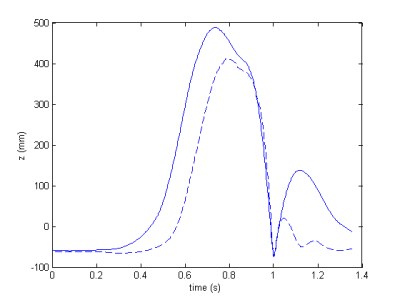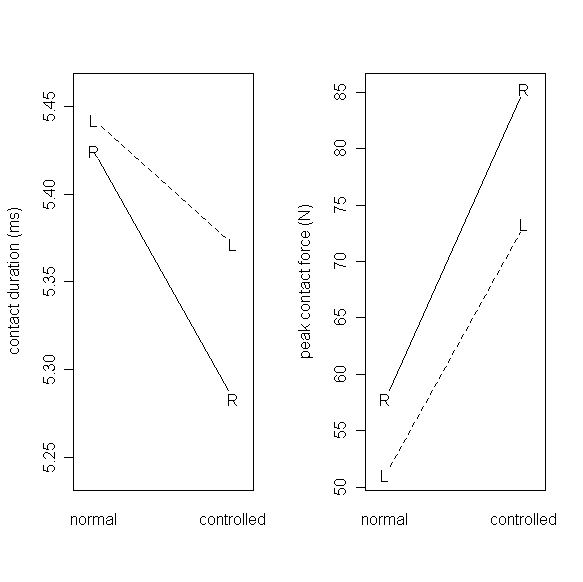


Movements and grip influence the contact force and sound in drumming
Sofia Dahl
Institute of Music Physiology and Musicians' Medicine
Hanover University of Music and Drama
E-mail: dr.sofia.dahl@gmail.com
Eckart Altenmüller
Institute of Music Physiology and Musicians' Medicine
Hanover University of Music and Drama
altenmueller@hmt-hannover.de
Popular version of paper 2aMUb1
"Motor control in drumming: Influence of movement pattern on contact force and sound characteristics"
This paper presents ongoing work with the aim to understand how differences in grip and movement patterns affect the force and sound characteristics in drumming. This is interesting because professional musicians mainly use auditory feedback when learning to control timbre and timing. However, the individual differences in movement patterns can be very large, which makes comparison and assessment of the movement strategies difficult.
For expert drummers the grip of the drumstick plays an important role in the control of timing and timbre. Normally, the stick is held so that it is free to rotate around a fulcrum point at the contact with thumb and index finger. The player strives to have control over the stick without hindering its movement, letting it freely strike and rebound from the drumhead. Strokes where the stick is free to move away from the drumhead after impact are believed to develop a fuller sound, as compared to strokes when the rebound of the stick is hindered (for instance by a too tight grip). However, on occasion the player may need to restrain a rebound that is too strong for the next stroke. For instance, to play a soft stroke immediately after a loud one, the player may adjust the grip to keep the stick from moving too high above the drumhead. Such strokes are sometimes called “control” or “down” strokes.
Whereas string players and wind instrumentalists have a continuous control of the acoustic sound parameters during the full length of a tone, a percussionists' direct contact with the instrument is typically limited to a few milliseconds. If a player needs to halt the stick, the adjustment of the grip may have to begin already before the stick hits the drumhead. Consequently, such strokes should sound a bit different because the grip and interaction between drumstick and drumhead has changed. The contact between drumstick and drumhead is so short that the timbre, attack characteristics, and sound level of a drum stroke are dependent on what happens immediately before the time of contact.
To investigate the effect of movements and grip on the sound we recorded movement, sound, force and contact duration between stick and drumhead during drumming. The movements were recorded by a motion capture system that measured the position of infra-red light emitting diodes attached as markers the hand hand and arm of professional players. A marker was also attached to a drumstick, equipped with sensors to measure contact force and duration of each stroke. The players played single, separated strokes with different instructions (assumed to influence the player's grip of the drumstick). “Normal” strokes were allowed to freely rebound from the drumhead. For “controlled” strokes the player was asked to control the ending position of the drumstick, stopping it as close as possible to the drumhead after the stroke.

Figure 1. Movement pattern of markers attached to the wrist, MPC-joint (bas of index finger) and drumstick during a normal stroke. The straight lines connect the markers every 25 ms. Note how the hand leads the stick up at the beginning of the stroke, before the stick is “whipped” down and then quickly bounces up from the drumhead.
In Figure 1 an example of the movement pattern for a normal stroke is shown. In the figure three curved traces show the displacement of three markers attached to the wrist (left, full line), the base of the index finger (MPC-joint, circles), and at the tip of the drumstick (right full line). To make the movement pattern clearer, the traces have been somewhat stretched out and every 25 milliseconds a line connects the individual markers, forming a “stick figure” of the hand and drumstick. The displacement of the wrist and index finger show a much smaller magnitude compared to that of the stick, which is flicked up and then whipped down with high velocity.
Figure 2 shows a comparison between the vertical displacement of the drumstick marker for a normal (full line) and a controlled (dashed line) stroke. As can be seen, the stick movement after the hit (at time 1 s) is considerable restrained for the controlled stroke in comparison to the normal.

Figure 2. Vertical displacement of the stick marker for a normal (full line) and controlled (dashed) stroke. Note the difference in the height of the rebound after the impact (at time 1 s).
Figure 3 shows the measured contact duration and force between stick and drumhead for normal and controlled strokes. Somewhat surprising the measured contact duration for normal strokes was longer compared to the controlled. This might seem contrary to the instruction to stop the drumstick as close as possible to the drumhead. One might expect that the stick would remain longer in contact with the drumhead when it is not allowed to freely rebound. However, the controlled strokes also showed a higher peak force, which indicates a higher acceleration and/or effective mass for these strokes. The change in grip could have affected the vibrations of the stick itself, making it stiffer and caused an “early departure” from the drumhead.

Figure 3. Contact duration (left panel) and peak force (right panel) for the different arms (right and left) and types of strokes measured for one player. The duration of contact between drumstick and drumhead was significantly shorter for the controlled compared to the normal strokes. The controlled strokes also showed higher peak force, with the highest force for the right arm. The difference between arms is to be expected because the preferred hand (right in this case) is typically stronger.
Are these differences perceivable? To investigate if the influence of playing instructions can be heard a listening test was performed (only including strokes from one player as stimuli). Eight non-drummers rated normal and controlled strokes with respect to timbre (from flat to full) and attack (from soft to hard). The normal strokes were rated as having more full timbre and harder attack compared to the controlled strokes. Example of strokes rated as full and flat can be heard here. Can you hear the difference?
To summarize: When instructed to control the position of the stick directly after the impact, the player adjusts the grip which alters the interaction between drumstick and drumhead. The controlled strokes display higher peak force and contact duration, and were rated as having softer attack and flatter timbre by listeners.
Acknowledgments:
This research is part of the project ASIAMS (MEIF-2006-039429) supported by the European Commission through a MOBILITY-2 Marie Curie Intra-European Fellowship.